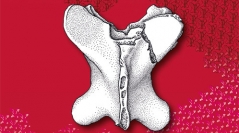

 Geodiversitas
42 (22) - Pages 409-426
Geodiversitas
42 (22) - Pages 409-426Amphibians and reptiles are decribed for the first time from the Cenozoic of Afghanistan. They originate from four Neogene localities. Sherullah 9 (late Miocene) yielded anuran amphibians (? Alytidae Fitzinger, 1843 (? Discoglossinae Günther, 1858), “Ranidae” Batsch, 1796 and another, indeterminate family), one chelonian, the terrestrial testudinine Agrionemys Khozatsky & Młynarski, 1966, which is compared to a Maragheh fossil specimen, and the genus still being present in the Kabul area; one indeterminate lizard, snakes (Colubridae Oppel, 1811 s.l. and two distinct snakes that pertain to either the Colubridae s.l. or Elapidae Boie, 1827). The faunas of the three other localities are very poor. Molayan (late Miocene) produced only one lizard (Varanus sp. Merrem, 1820, Varanidae Gray, 1827). Pul-E Charkhi (early Pliocene) yielded indeterminate anurans, one indetermined lizard and colubrid snakes. Only an indeterminate anuran family is known at Hadji Rona (early Pliocene). Then, as known, the fauna is constituted of families which still have representatives living in Afghanistan.
Afghanistan, Amphibia, Anuran, Reptilia, turtles, lizards, snakes, Miocene, Pliocene